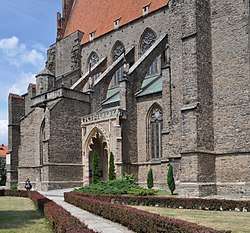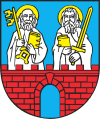Strzegom
| Strzegom | ||
|---|---|---|
 Parish Church of Saints Peter and Paul in Strzegom | ||
| ||
 Strzegom | ||
| Coordinates: 50°57′40″N 16°20′40″E / 50.96111°N 16.34444°E | ||
| Country |
| |
| Voivodeship | Lower Silesian | |
| County | Świdnica | |
| Gmina | Strzegom | |
| Government | ||
| • Mayor | Zbigniew Suchyta | |
| Area | ||
| • Total | 20.49 km2 (7.91 sq mi) | |
| Elevation | 230 m (750 ft) | |
| Population (2006) | ||
| • Total | 16,782 | |
| • Density | 820/km2 (2,100/sq mi) | |
| Time zone | UTC+1 (CET) | |
| • Summer (DST) | UTC+2 (CEST) | |
| Postal code | 58-150 | |
| Car plates | DSW | |
| Website | http://www.strzegom.pl | |
Strzegom [ˈstʂɛɡɔm] (German: Striegau) is a town in Świdnica County, Lower Silesian Voivodeship, in south-western Poland. It is the seat of the Gmina Strzegom administrative district (gmina). It lies approximately 15 kilometres (9 mi) north-west of Świdnica, and 52 kilometres (32 mi) west of the regional capital Wrocław. As at 2006, the town had a population of 16,782.
History
Traces of settlement on the site during the Roman Empire period have been found. In the Middle Ages it was a fortified settlement under the rule of a castellan, part of Piast Poland, first mentioned in a deed issued by Pope Hadrian IV in 1155, confirming the boundaries of the Wrocław diocese. At the same time the building of the St. Peter and Paul parish church began, from 1203 under the patronage of the Order of Saint John. About 1242, Strzegom received town privileges by Anne of Bohemia, widow of the Silesian duke Henry II the Pious. In 1248 it fell to the Silesian Duchy of Legnica under Henry's son Bolesław II the Bald, contested by his nephew Henryk IV Probus, who, imprisoned by his uncle at Jelcz, finally had to renounce Strzegom in 1277.
From the late 13th century the town of Striegau belonged to the Duchy of Jawor and Świdnica under Bolko I the Strict, and until 1392 was ruled by his descendants of the Silesian Piasts. Though they initially withstood the vassalisation attempts by King John of Bohemia, Striegau subsequently shared the political fortunes of Silesia, and passed from Polish to Imperial Bohemian rule and in 1526 to Austrian Habsburg sovereignty. During the Thirty Years' War the city suffered almost complete destruction.
In 1742 Striegau became part of Prussia. On June 4, 1745 the Battle of Hohenfriedberg, an important victory for King Frederick II during the War of the Austrian Succession, took place near the town. In the 19th century considerable industrial expansion took place, with granite quarries playing a particularly important role in the town's economy. The first rail link to the town was opened in 1856. In 1905 the town of Striegau had 13,427 inhabitants. During World War II, Nazi Germany used an area close to the town as a subcamp of the nearby Gross-Rosen concentration camp. The town was renamed Strzegom by the People's Republic of Poland and the expelled German inhabitants replaced with Polish settlers.
The Parish Church of Saint Peter and Saint Paul is one of Poland's official national Historic Monuments (Pomnik historii), as designated October 22, 2012. Its listing is maintained by the National Heritage Board of Poland.
In 2012 the Jewish Cemetery of Strzegom was fully restored and renovated. Over 80 gravestones (Matzevahs) were repaired and returned to their original place. The project was jointly funded by Poland and the European Union, simultaneously introducing Jewish culture and history to the local townspeople.
Notable residents
- Johann Christian Günther (1695-1723), Baroque poet
- Hans-Georg Koitz (born 1935), Roman Catholic bishop of Hildesheim (1992-2010)
- Herbert Obst (born 1936), Olympic fencer
- Paul Slowinski, Polish-Australian kickboxer
External links
| Wikimedia Commons has media related to Strzegom. |
- Jewish Community in Strzegom on Virtual Shtetl

Coordinates: 50°57′40″N 16°20′40″E / 50.96111°N 16.34444°E
